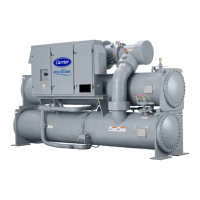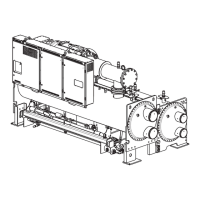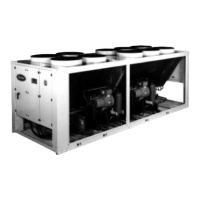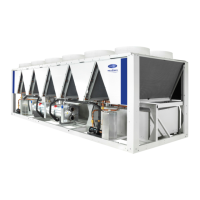62
Modify Minimum and Maximum Load Points (
∆
T1/P1;
∆
T2/P2) If NecessaryT — These pairs of chiller load points,
located on the OPTIONS screen, determine when to limit guide
valve travel or open the hot gas bypass valve when stall pre-
vention is needed. These points should be set based on individ-
ual chiller operating conditions.
If after configuring a value for these points, stall prevention
is operating too soon or too late for conditions, these parame-
ters should be changed by the operator.
An example of such a configuration is shown below.
Refrigerant: HCFC-134a
Estimated Minimum Load Conditions:
44 F (6.7 C) LCW
45.5 F (7.5 C) ECW
43 F (6.1 C) Suction Temperature
70 F (21.1 C) Condensing Temperature
Estimated Maximum Load Conditions:
44 F (6.7 C) LCW
4 F (12.2 C) ECW
42 F (5.6 C) Suction Temperature
8 F (36.7 C) Condensing Temperature
Calculate Maximum Load
— To calculate the maximum load
points, use the design load condition data. If the chiller full load
cooler temperature difference is more than 15 F (8.3 C), esti-
mate the refrigerant suction and condensing temperatures at
this difference. Use the proper saturated pressure and tempera-
ture for the particular refrigerant used.
Suction Temperature:
42 F (5.6 C) = 37 psig (255 kPa) saturated
refrigerant pressure (HFC-134a)
Condensing Temperature:
98 F (36.7 C) = 120 psig (1827 kPa) saturated
refrigerant pressure (HFC-134a)
Maximum Load
∆
T2:
54 – 44 = 10º F (12.2 – 6.7 = 5.5º C)
Maximum Load
∆
P2:
120 – 37 = 83 psid (827 – 255 = 572 kPad)
To avoid unnecessary surge prevention, add about 10 psid
(70 kPad) to |P2 from these conditions:
∆
T2 = 10º F (5.5º C)
∆
P2 = 93 psid (642 kPad)
Calculate Minimum Load
— To calculate the minimum load
conditions, estimate the temperature difference the cooler will
have at 10% load, then estimate what the suction and condens-
ing temperatures will be at this point. Use the proper saturated
pressure and temperature for the particular refrigerant used.
Suction Temperature:
43 F (6.1 C) = 38 psig (262 kPa) saturated
refrigerant pressure (HFC-134a)
Condensing Temperature:
70 F (21.1 C) = 71 psig (490 kPa) saturated
refrigerant pressure (HFC-134a)
Minimum Load
∆
T1 (at 20% Load): 2 F (1.1 C)
Minimum Load
∆
P1:
71 – 38 = 33 psid (490 – 262 = 228 kPad)
Again, to avoid unnecessary surge prevention, add 20 psid
(140 kPad) at
∆
P1 from these conditions:
∆
T1 = 2 F (1.1 C)
∆
P1 = 53 psid (368 kPad)
If surge prevention occurs too soon or too late:
The differential pressure (
∆
P) and temperature (
∆
T) can be
monitored during chiller operation by viewing
ACTIVE
DELTA P
and
ACTIVE DELTA T
(HEAT_EX screen). Com-
paring
STALL/HGBP DELTA T
to active
DELTA T
will deter-
mine when the STALL PREVENTION function will occur.
The smaller the difference between the
STALL/HGBP DELTA
T
and the
ACTIVE DELTA T
values, the closer to stall
prevention.
MODIFY EQUIPMENT CONFIGURATION IF NECES-
SARY — The EQUIPMENT SERVICE table has screens to
select, view, or modify parameters. Carrier’s certified drawings
have the configuration values required for the jobsite. Modify
these values only if requested.
SERVICE Screen Modifications
— Change the values on
these screens according to specific job data. See the certified
drawings for the correct values. Modifications can include:
• chilled water reset
• entering chilled water control (Enable/Disable)
• 4 to 20 mA demand limit
• auto restart option (Enable/Disable)
• remote contact option (Enable/Disable)
Owner-Modified CCN Tables
— The following EQUIP-
MENT CONFIGURATION screens are described for refer-
ence only.
OCCDEFCS —
The OCCDEFCS screen contains the Local
and CCN time schedules, which can be modified here or on the
SCHEDULE screen as described previously.
HOLIDAYS —
From the HOLIDAYS screen, the days of the
year that holidays are in effect can be configured. See the holi-
day paragraphs in the Controls section for more details.
BRODEF —
The BRODEF screen defines the start and end of
daylight savings time. Enter the dates for the start and end of
daylight savings if required for your location. BRODEF also
activates the Broadcast function which enables the holiday
periods that are defined on the CVC to take effect.
Other Tables
— The CONSUME, NET_OPT, and RUN-
TIME screens contain parameters used with a CCN system.
See the applicable CCN manual for more information on these
screens. These tables can only be defined from a CCN Build-
ing Supervisor.
LOAD
STALL
PREVENTION
OCCURS TOO
SOON
STALL
PREVENTION
OCCURS TOO
LATE
At low loads
(<50%)
Increase P1 by
10 psid (70 kPad)
Decrease P1 by
10 psid (70 kPad)
At high loads
(>50%)
Increase P2 by
10 psid (70 kPad)
Decrease P2 by
10 psid (70 kPad)

